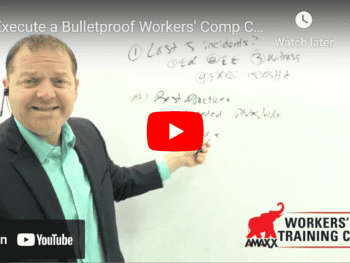
Like the defense-oriented football fanatic, claim handlers and other interested stakeholders should understand their options for a new claim and put on the best “D-FENCE.” Understanding that even the most iron-clad defense may not save the day is critical. Denying primary liability or ongoing medical care must be done cautiously and skillfully.
Click Link to Access Free PDF Download
“Avoid the 3 Primary Reasons Injured Workers’ Hire Attorneys”
Blitz the QB: Denying Primary Liability
The issue of accepting a claim is the first significant decision a member of the claim management team must make. A careful analysis must determine if the injury “arose out of” and was in the “course of” employment. All denials of primary liability should be done in plain language and provide a factual and legal basis for not accepting a claim. Not doing so will result in administrative penalties and additional exposure.
- Arising out of: Refers to instances when the employment reasonably appears to create a causal connection between the conditions the employer puts about the employee and the resulting injury.
- Course of: Refers to the time, place, and circumstances of the accident.
These issues have an inherent complexity, which much more can be discussed.
Third and Long: Understanding Affirmative Defenses
Even if the work injury arose from and in the course of employment, skilled claim handlers and other defense interests should consider whether the claim can be correctly denied through an affirmative defense. Common defenses to work injuries include:
- Notice: Every workers’ compensation act requires employees to report the incident correctly within a specified timeframe. While these timeframes are generally generous, the employee does carry the burden of taking affirmative steps to notify the employer (via a representative)
- Statute of Limitation: Limitations are placed on how long it can take for an incident to manifest into an actual work injury. The rationale is that it provides certainty for all parties and fundamental fairness. Injuries not acted upon in terms of medical care should be scrutinized in this defense.
- Prohibited Acts: Employers who expressly prohibit their employees from engaging in certain activities and consistently enforce these policies can receive legal protection. Common themes in case law include operating machinery or equipment without specified training or certification and untraining employees to perform certain activities or engage in certain conduct.
- Intentional Misconduct: While horseplay is generally compensable in workers’ compensation, some activities go beyond that threshold. These activities include a purposeful violation of safety rules that result in injuries on the job.
- Intoxication: Evidence an employee was under the influence of legal or illegal substances such as drugs or alcohol and is injured may not be eligible for workers’ compensation benefits. The barrier to successfully asserting this defense is the requirement that the intoxication must be the “proximate cause” of the injury.
- Medical Causation: Issues of medical causation or won and lost often in the “battle of the experts.” Successful use of this defense is often asserted retroactively after receiving an independent medical examination (IME) report.
All of these defenses are very fact-dependent and have specific elements. All stakeholders should be open to the strengths and weaknesses of each defense as information is gathered during the discovery process. Defense attorneys play a vital role in advising clients and providing ongoing legal analysis.
Prevent Defenses: Other Defenses to Consider
The defense of a workers’ compensation claim should not stop after determining primary liability. Other issues to consider include:
- Nature and extent of the work injury: Arguments that the injury was temporary in nature and fully resolved.
- Reasonableness and necessity of medical care: Always be on the lookout for excessive medical care and charges.
- Issues concerning Maximum Medical Improvement (MMI): Wage loss benefits are often discontinued once the employee reaches MMI – the end of the healing period.
The other defenses possible can be endless. The critical thing to remember is that all interested stakeholders should attempt to get the employee back to work as quickly as possible. This can include the issue of a vocational counselor or expert to assist.
Conclusions
Workers’ compensation claims can be like a football game, requiring an excellent defense to win. Now is the time to review your claim handling practices and how you work with defense counsel to stop bad claims in their tracks and force a turnover – judicially denial of a claim. Use these concepts with compassion to reduce workers’ compensation program costs and ensure the injured employee receives all benefits they are entitled to receive.

Contact: mstack@reduceyourworkerscomp.com.
Workers’ Comp Roundup Blog: http://blog.reduceyourworkerscomp.com/
©2023 Amaxx LLC. All rights reserved under International Copyright Law.
Do not use this information without independent verification. All state laws vary. You should consult with your insurance broker, attorney, or qualified professional.














